has introduced a number of programs that were
Burrstone Road in 1961. The 110 acre state
the first of their kind in the nation.”
hospital farmland known as Graycroft Farm
In its first three years, enrollment at Utica
was transformed into a college campus, but the
College doubled from 600 to 1,200. A faculty
school had only one building when it was ded-
of twenty-four grew to an instructional staff of
icated on October 19. Additional buildings,
sixty. By 1949 the college had purchased nine
however, were soon constructed.
buildings, discontinued four others, and contin-
The college was resolute in its efforts to
ued leases of the Plymouth Church House, the
offer a mix of liberal arts and career programs.
Science Center and the Moose Building known
It also surpassed a majority of other liberal
as the Little Theatre.
arts colleges of similar size by instituting pre-
“The Syracuse University Extension Center
professional and professional programs. Utica
at Utica Free Academy had become a college
College became separately accredited in 1978,
campus earlier by the will of active proponents,
and became legally independent in 1995, but
not the plodding of well-intentioned committees,”
maintained an academic relationship with
Professor Behrens explains in his history of
Syracuse University and offered the SU degree
the school.
until 2011.
S h a r i n g t h e H e r i t a g e ✦ 9 9
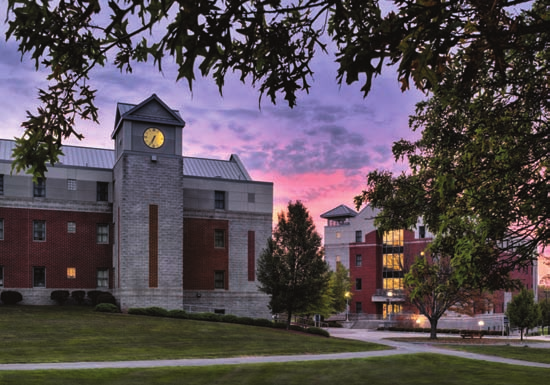
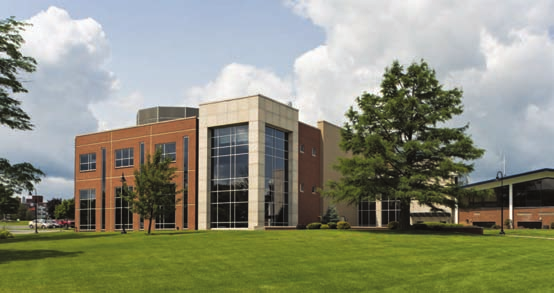
XXON Sharing the Heritage_Layout 1 1/23/2015 11:16 AM Page 100
The College offers thirty-six
undergraduate degrees in more than
sixty areas of study as well as
numerous pre-professional and spe-
cial programs. The school also
offers twenty-one graduate pro-
grams, including master’s degrees,
doctoral programs and graduate
level certificates. Options include
Business Administration, Cybersecurity
(intelligence, forensics, and opera-
tions), Economic Crime Management,
Education, Health Care Administration,
Liberal Studies, Occupational Therapy,
and Physical Therapy.
The school employs 742, including
152 full-time faculty members.
“We’ve always been known as the
school of opportunity and that ‘golden
❖
Today, Utica College is a fully auto-
thread of innovation’ continues to guide the
Above: Utica College tower bell
nomous, private higher education institution,
college today,” says Dr. Hutton. He recalls that
at dusk.
offering bachelor’s, master’s, and professional
the school’s reputation for innovation began
doctoral degrees.
soon after the school opened when a returning
Currently, Utica College enrolls 2,200 full-
GI and professor persuaded school officials to
and part-time undergraduate students, and
create the first public relations program at an
about 300 full-time graduate students. Students
undergraduate level. That program has since
are enrolled from forty-five different states and
been voted one of the 100 most influential
thirty-nine different countries, representing a
programs in the country. One of the first
broad diversity of ethnicities, backgrounds, per-
post-World War II construction management
spectives and experiences. Seventy-seven per-
programs was established at Utica College. The
cent of the freshmen students live on campus.
second Psychology-Child Life program in the
In addition, 1,700 students are enrolled in
country began at the school and the standards
eleven on-line degree and certificate programs.
for the profession were written on its campus.
1 0 0 ✦ O N E I D A C O U N T Y : A n I l l u s t r a t e d H i s t o r y
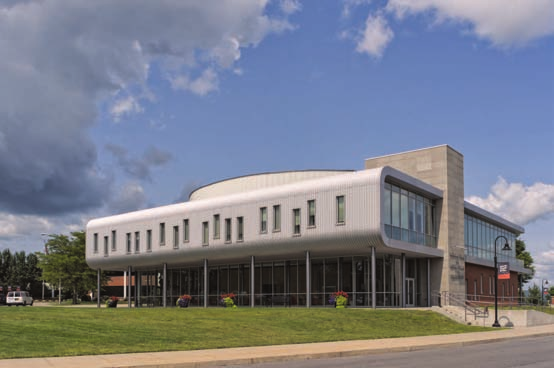

XXON Sharing the Heritage_Layout 1 1/23/2015 11:16 AM Page 101
“We also have the first Economic Crime
Utica College fields twenty-five varsity
Investigation Program, which was established
sports teams and is a member of the NCAA’s
in 1988 when people weren’t even thinking
Division III Empire 8, Eastern College Athletic
about teaching white-collar crime investiga-
Conference and the New York State Women’s
tion,” Dr. Hutton adds. “We also have one of
Collegiate Athletic Association. Students also
the first security intelligence programs in the
participate in sixteen intramural sports and
nation and are the first school in the country
club sports.
to be certified by the Department of Defense
In its relatively short history, Utica College
and the National Security Agency for our
has grown from a two-year extension school
Cybersecurity program.”
in makeshift quarters to a highly respected
In connection with these cutting-edge pro-
institution of higher educa-
grams, the school constructed an Economic
tion. Utica College’s mission
Crime, Justice Studies, and Cybersecurity
rests upon a foundation of
Building that includes a certified crime lab
values that guide the College
where cybercrime analysis is done for Federal
community’s decisions and
and State agencies in Central New York.
actions. These values include
The building includes a top secret-qualified
individual attention for its
research space where defense-related cyber
students; lifelong learning; a
research can be conducted.
pragmatic approach to teach-
The school’s Frank E. Gannett Memorial
ing and learning; continued
Library houses 145,000 volumes, 657 print
improvement in its education-
journals, 5,000 electronic journals and 112
al and operational quality; a
on-line databases. The library contains the
diversity of perspective; back-
largest collection of nineteenth and early
ground and experience in an
twentieth century Welsh language literature in
increasingly global society;
the United States.
community and professional
Utica College serves locally as a vital con-
service; ethical behavior and
tributor to the region’s economic development,
integrity in all that it does;
and has also established branches in Syracuse
freedom of expression and the
and in St. Petersburg, Florida where it offers
open sharing of ideas and cre-
an innovative Accelerated Second Bachelor’s
ativity; open, honest and col-
Degree nursing program that admits seventy-
legial communication and the
two students three times a year.
well being of others.
S h a r i n g t h e H e r i t a g e ✦ 1 0 1
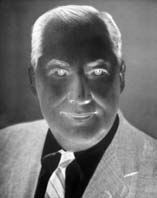
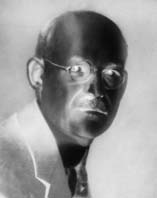
XXON Sharing the Heritage_Layout 1 1/23/2015 11:16 AM Page 102
From old-timey suspenders to modern engi-
into the second half of the twentieth century.
STURGES
neered straps and webbing, Sturges Manufacturing
The company, however, continued to suffer
Company, Inc., has survived and prospered for
financially because of declining sales and the
MANUFACTURING
more than a century by constantly reinventing
effect of plummeting cotton prices on inventory.
CO., INC.
itself to meet the demands of the market.
The National Recovery Act, part of the gov-
The company was first incorporated as the
ernment efforts to combat the Depression,
Utica Suspender Company, Inc., on February 3,
implemented policies that boosted cotton
1909. The founders were George Armstrong,
prices. This also increased the value of the
Henry Sturges, and George H. Williams.
Sturges inventory, allowing the company to post
Armstrong served as president and Sturges
a profit for 1933.
as secretary.
Meanwhile, Edwin Weiss joined the company
The new company rented manufacturing
and led the development of a new product
space at 335 Columbia Street in Utica and
line of surgical and corset webbings. These
began producing Utica Athletic Suspenders,
new offerings contributed to record webbing
which retailed for twenty-five cents per pair.
production and a forty percent increase in
The company promoted its products aggressively
sales during 1934. The company soon added
with an advertising budget of $3,000, enough
“bathing belts”, which increased sales substan-
to purchase ads in such popular magazines as
tially in 1936. Despite the gloomy economy,
Argosy and The Saturday Evening Post.
Sturges Manufacturing was once again moving
As automobiles began to play a major role
in a positive direction.
in American life, the company recognized an
Sturges died in 1939 and was succeeded as
opportunity to utilize non-elastic webbing
company president by Weiss. The new leader was
straps to secure trunks and luggage to autos.
convinced that the factory needed to be expand-
A new line of “U-T-K” straps was developed
ed to accommodate more weaving equipment
❖
and by the end of 1915, the straps accounted
and, in 1941, the company added six looms
Above: Henry G. Sturges, president
for ninety percent of the company orders.
and boosted production to aid the war effort.
1919-1939.
World War I created a shortage of webbing
During World War II, ninety-five percent of
and by 1918 the company was having great
production was devoted to government work,
Below: Edwin T. Weiss, president
difficulty in finding enough raw materials. To
including gun slings and berth straps for troop
1939-1992.
solve the problem, the company purchased
transport ships. During the war years, Sturges
property on Sunset Avenue in South Utica and
operated two forty-eight hour shifts each week
built its own factory to accommodate twelve
and produced more than four million straps
shuttle looms. The building was located at
for the armed forces, including two million
2030 Sunset Avenue in South Utica.
gun slings. Production workers during this era
After a four year period of declining sales of
included many wives and mothers eager to
suspenders and automobile straps, the company
support the efforts of their loved ones who were
name was changed to Sturges Manufacturing
off fighting the war.
Company in 1923. A year later, both product
The end of the war meant another major
lines were discontinued and the company
change in direction for the company as it
became a miscellaneous strap business.
shifted from war production to commercial
Although the company reported its lowest sales
work. New products included straps for garden
in four years, 1924 proved to be the firm’s most
sprayers, baby high chairs, roller skates and
profitable to date. The “U-T-K” 4-Way Book
improved safety patrol belts. To meet the
Strap was introduced that year and a U.S. Patent
tremendous economic boom that followed
was granted for the design.
World War II, the company added an additional
As the Great Depression spread across the
seven looms and diversified the product line
nation, Sturges lost two of its most significant
to include straps for Kodak cameras, IBM
accounts and sales declined by forty percent in
electric typewriters and shoulder straps for
1930. To survive, the company developed the
Kirby vacuum cleaners. These products also
Safety Patrol Belt for school crossing guards.
introduced new materials such as nylon,
The patrol belts were a best selling product well
polyester and polypropylene yarns.
1 0 2 ✦ O N E I D A C O U N T Y : A n I l l u s t r a t e d H i s t o r y


XXON Sharing the Heritage_Layout 1 1/23/2015 11:17 AM Page 103
A significant industry shift occurred during
the 1960s with the introduction of the shuttle-
less high-speed needle looms that increased
production dramatically. With orders from
Kodak approaching 50,000 straps per week, an
addition was added to the west side of the
building to house new high-speed looms.
During the 1970s and 1980s, straps for the
camping, lawn and garden, exercise equipment,
safety and O.E.M markets were added to the
Sturges product line.
Richard Griffith, who had joined the company
in 1972, was elected president in 1992. Old
style shuttle looms were phased out, freeing
up space for more modern manufacturing
equipment. In addition, the company purchased
an adjacent bowling alley and doubled its
manufacturing space to 60,000 square feet.
By the turn of the century, Sturges began
to see customers migrating to offshore manufac-
turers for the cost advantage, although surveys
not the company, but the commodity product
❖
showed Sturges straps were of the highest
line. Utilizing the strengths of an ISO quality
Above: Sturges management team,
quality. Nevertheless, the time had come for
management system, the firm’s knowledge of
from left to right, Vice President/Sales
the company to reinvent itself once again.
manufacturing and a willingness to innovate,
Manager Tyler Griffith, General
Griffith’s son, Tyler, who now serves as vice
Sturges reinvented itself to be a producer of
Manager Bruce Brach, President
president of Sales, realized the problem was
engineered webbing.
Richard Griffith, Vice President/
Quality Manager Norma Jean Rice
and Human Resources Manager/
Accounting Manager Mylissa Deetz.
Left: A production worker operates
a multifunctional machine to
simultaneously cut, sew and create
a screw hole in an O. E. M.
webbing strap.
S h a r i n g t h e H e r i t a g e ✦ 1 0 3
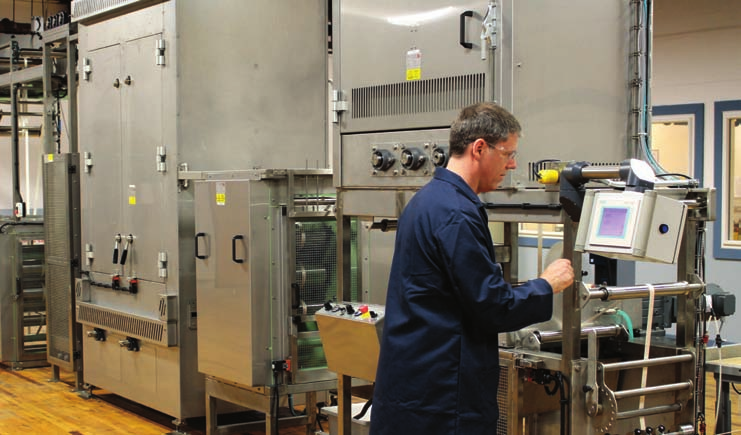
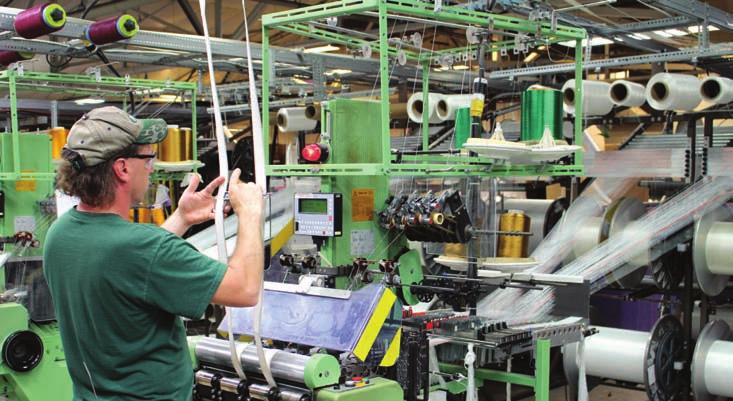
XXON Sharing the Heritage_Layout 1 1/23/2015 11:17 AM Page 104
❖
Sturges is now recognized as a leader in
was selected as one of the Best Companies to
Above: A technician applies an
webbing for producers of fall protection,
Work for in New York in 2014.
abrasion treatment to a webbing.
mountaineering and fire protection equipment,
After successfully meeting the changing
as well as for original equipment manufacturers
needs of the market place for more than a
Below: A weaving technician checks
who have unique requirements. The company
century, Sturges Manufacturing Co. looks
the width of a webbing at a
has been honored as Supplier of the Year by
forward to a bright future. For additional
needle loom.
a number of industry-leading customers and
information, visit www.sturgesstraps.com
1 0 4 ✦ O N E I D A C O U N T Y : A n I l l u s t r a t e d H i s t o r y
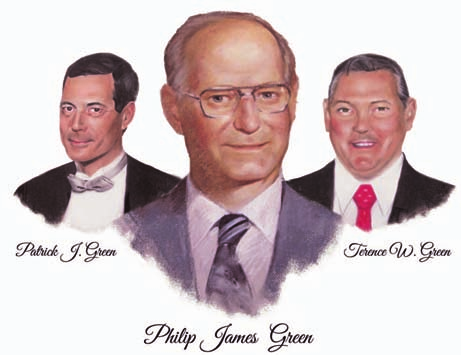
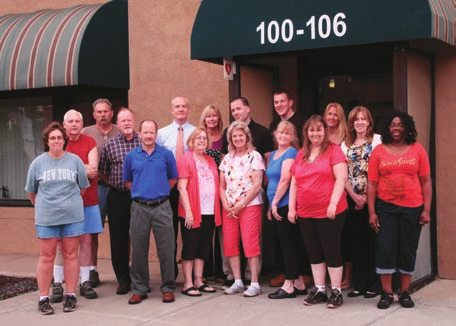
XXON Sharing the Heritage_Layout 1 1/23/2015 11:18 AM Page 105
PJ GREEN, INC.
PJ Green, Inc., the leading variable printing and
the residents of nearby communities. Since the
❖
mailing firm in Central New York, was established
purchase, circulation and content has more than
Above: Founder Philip James Green
in 1928 by Philip J. “PJ” Green as PJ Green
doubled. PJ Green further expanded during
and his sons, Patrick and Terence.
Advertising Service. PJ, his wife Anna Mae, and
this time by adding graphic design, integrated
their five children began the business in the garage
marketing, variable printing and promotional
Below: Employees with twenty-plus
of the family home on Albany Street in Utica.
products to their service offerings.
years of service along with the
PJ began his career by delivering advertising
With the recent addition of PJ’s great-grand-
third and fourth generations of the
circulars and promotional items door-to-door.
children, the company is now a fourth generation
Green family.
Soon he was able to process mailed advertising
family business. In keeping with the family
COURTESY OF TONY NARKON.
and other forms of volume distribution. As the
culture, many employees have over twenty years
firm continued to grow, PJ’s sons Terry and Pat
of service. PJ Green is poised to continue its
joined their father and the company soon
success by providing innovative solutions for its
became incorporated.
clients and by retaining its dedicated employees.
PJ ran the business for more than fifty years
until his death in 1982. Terry succeeded his
father as president and Pat as vice president and a
second production facility was added in Syracuse
that same year. To accommodate their continued
growth, in 1987 the company moved into a four-
story, 125,000 square foot facility on Whitesboro
Street, Utica. The main production facility and
corporate offices remain at this location today,
while a third office was opened in Albany in 2009.
Terry and Pat continued to build the family
business until their untimely deaths. After Terry’s
passing in 1990, the family and employees were
committed to keeping the company intact. Four
of Terry’s children still operate the business today.
The new millennium brought diversification
to PJ Green when the company purchased the
Town Crier, a ‘good news’ publication serving
S h a r i n g t h e H e r i t a g e ✦ 1 0 5

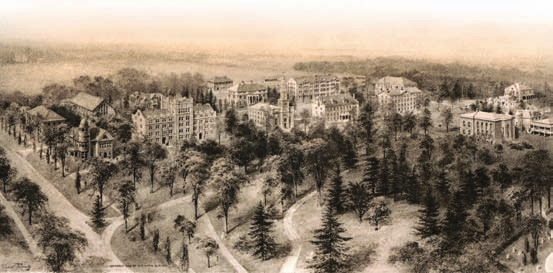
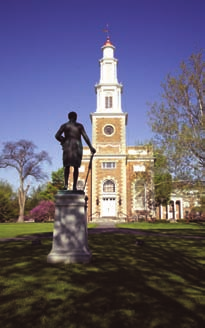
XXON Sharing the Heritage_Layout 1 1/23/2015 11:18 AM Page 106
HAMILTON
COLLEGE
❖
Hamilton College, one of the nation’s most
The school placed great emphasis on ‘rhetoric
Above: Landscape illustration of
highly regarded liberal arts colleges, has always
and elocution’ and excellence in public speaking
Hamilton College, 1908.
been a school of opportunity. This heritage dates
remains a Hamilton tradition.
BY RICHARD W. RUMMELL, (1848-1924).
from 1793 when Samuel Kirkland, a missionary
As Hamilton entered its second century in
to the Oneida Indians, developed a plan to
1912, it began preparing itself for the modern
BELOW: PHOTO BY VICKERS & BEECHLER.
educate the tribe’s children. His idea called for
era. An ambitious building program resulted in
a school to serve both the Oneidas and the
facilities that were the envy of peer institutions,
BOTTOM, RIGHT: PHOTO BY NANCY L. FORD.
white settlers who were beginning to move
and the curriculum was revised to accommodate
into the area in search of land and opportunity
modern languages and the sciences. Under the
following the American Revolution.
leadership of President Carlos Ferry, Hamilton
Kirkland presented his plan to President
achieved solid academic status among America’s
George Washington and Secretary of the
leading liberal arts institutions. Actively
Treasury Alexander Hamilton, both of whom
supported by 1864 Hamilton graduate and
expressed support. Hamilton lent his name to
Clinton native Elihu Root, the distinguished
the school and became one of the first trustees.
statesman and Nobel Prize laureate who was
The Hamilton-Oneida Academy was char-
chairman of the board of trustees, President
tered soon afterward and, on July 1, 1794, the
Ferry nurtured Hamilton as a place for the
cornerstone of the first building was laid in
finest teaching.
colorful ceremonies attended by a delegation of
The pace of change accelerated in the
Oneida Indians.
aftermath of World War II. The student body
The academy remained in existence for nearly
was expanded; both in size and quality, and
twenty years, although few Oneidas attended
the faculty grew in size and stature. The social
the school and the students were mostly the
sciences became a vital part of the curriculum
children of local white settlers. The academy,
through such course offerings as anthropology,
however, remained one of Kirkland’s enduring
economics, and government.
accomplishments when it was transformed into
Hamilton College a few years after his death.
The new institution of higher learning was
chartered in 1812. It is currently the third
oldest college in New York State and remains
one of the oldest in the nation. After surviving
dire difficulties in its early years, Hamilton
College began to flourish in the period prior
to the Civil War. Students were expected to
enter the school well prepared in Greek and


















